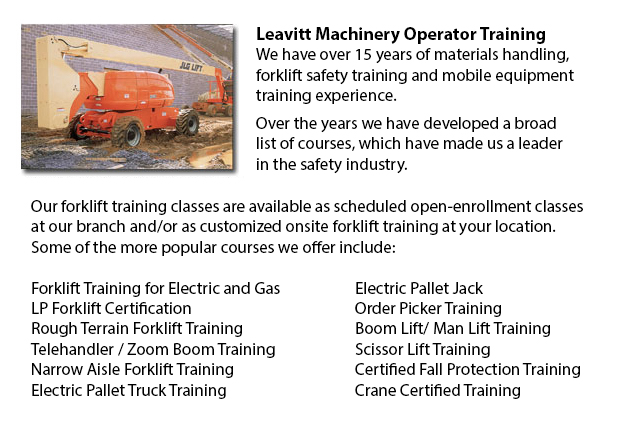
Brampton Boom Lift Certification - Elevated work platforms allow work and maintenance operations to be carried out at levels that could not be reached by any other way. Boom Lift Certification Training teaches workers about the safe operation of scissor lifts and boom lifts.
When work platforms are operated unsafely, they have the possibility for serious injury and even death, regardless of their lift style, site conditions or application. Electrocution, falls, tip-overs and crushed body parts could be the terrible outcome of wrong operating procedures.
In order to avoid aerial lift accidents, boom lift operators must be trained by qualified workers in safely operating the certain type of aerial lift they would be making use of. Aerial lifts should not be be altered without the express permission of the manufacturer or other recognized entity. If you are renting a lift, make certain that it is correctly maintained. Before utilizing, safety devices and controls have to be inspected to ensure they are functioning properly.
It is essential to follow safe operating procedures in order to avoid workplace accidents. Driving an aerial lift while the lift is extended must not be done, however, a few models are designed to be driven when the lift is extended. Set outriggers, if available. Always set brakes. Avoid slopes, but when necessary use wheel chocks on slopes that do not exceed the slope restrictions of the manufacturer. Follow manufacturer's load and weight limitations. When standing on the platform of boom lifts, make use of a safety belt with a two-foot lanyard tied to the basket or boom or a full-body harness. Fall protection is not required for scissor lifts which have guardrails. Never climb or sit on guardrails.
The boom lift certification course provides instruction in the following areas: training and certification; safety guidelines to prevent a tip-over; checking the work area and travel path; surface conditions and slopes; other tips for maintaining stability; stability factors; leverage; weight capacity; pre-operational inspection; testing control functions; mounting a vehicle; safe operating practices; safe driving procedures; power lines and overhead obstacles; utilizing lanyards and harness; PPE and fall protection; and prevent falling from the platform.
The trainee who is successful would learn the following: authorization and training procedures; pre-operational check procedures; how to avoid tip-overs; factors affecting the stability of scissor and boom lifts; how to utilize the testing control functions; how to utilize PPE and fall prevention strategies.
-
Brampton Aerial Boom Lift Ticket
Brampton Aerial Boom Lift Ticket - Aerial lift trucks might be used to accomplish several different tasks executed in hard to reach aerial places. Many of the tasks associated with this style of jack include performing routine maintenance on building... More -
Brampton Aerial Lift Train the Trainer
Brampton Aerial Lift Train the Trainer - The Aerial Lifts Train the Trainer Certification Program would teach trainers how to efficiently train operators in safe industrial mobile equipment operation. Trainers are provided with in-depth instruction o... More -
Brampton Zoom Boom Training
Brampton Zoom Boom Training - Zoom Boom Training is intended to train operators on variable reach forklifts. The goals of the training are to be able to impart an understanding of the physics of the machinery, and to be able to outline the operator's... More -
Brampton Heavy Equipment Operator Training
Brampton Heavy Equipment Operator Training - Heavy equipment operator training facilities that provide good standards within the industry, providing field performance work and additional machinery training are really sought after training features. S... More -
Narrow Aisle Forklift / Order Picker Training / Electric Pallet Jack / Electric Pallet Truck Training in Brampton
A pallet haul is equipment built in particular for moving pallets of irregular weights and dimensions. They may be used in conjunction with cranes, forklifts and other heavy duty equipment as an appendage piece or to be employed on their own. Pallet... More -
Brampton Overhead Crane Safety Training
Brampton Overhead Crane Safety Training - Overhead crane safety training equips operators with knowledge and skills regarding crane safety measures, accident avoidance, materials handling, and equipment and stock protection. Trainees will learn the k... More -
Brampton Crane Safety Training
Brampton Crane Safety Training - Companies and crane drivers have to know the problems associated to crane safety. Legislation provides rules for the safe maintenance, operation and inspection of lifting machines across North America. Crane Safety co... More -
Brampton Telehandler Training
Brampton Telehandler Training - Telescopic handlers normally known as telehandlers for short, are a really popular piece of heavy construction machinery. They are usually utilized in the construction and agricultural trades. These machines have farth... More

Forklift Certification Brampton
TOLL FREE: 1-888-254-6157
Brampton, Ontario
forkliftcertificationbrampton.com
Email Us
About Us


